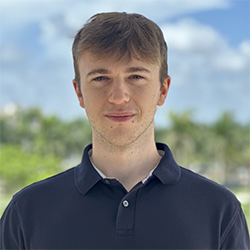Infrastructure Systems: Human-in-the-loop Digital Twins for Smart Cities
Led by Jinwoo Jang, Ph.D.
REU Scholar: Anton Rajko
REU Scholar Home Institution: Florida Atlantic University
REU Scholar: Asif Chowdhury
REU Scholar Home Institution: Lehman College
REU Mentor: Jinwoo Jang, Ph.D.
Unity-Based Digital Twin Traffic Simulation of West Palm Beach with LiDAR Vehicle Detection
This project focuses on the integration of LiDAR technology for the object detection of vehicles within a digital twin simulation of West Palm Beach, developed using Unity. The digital twin provides a detailed and interactive 3D representation of West Palm Beach, offering a dynamic environment for testing and visualization. By leveraging the precision and reliability of LiDAR sensors, the system aims to accurately identify and track vehicular movements and mirror them into the Unity simulation. The project demonstrates the potential of combining advanced sensing technologies with immersive simulations to enhance urban planning, traffic management, and smart city applications. Through this integration, stakeholders can gain valuable insights into traffic patterns and infrastructure usage, facilitating more informed decision-making and improved urban mobility solutions.
REU Scholar: Dana Smith
REU Scholar Home Institution: Florida Atlantic University
REU Mentor: Jinwoo Jang, Ph.D.
Newly available Photorealistic 3D tiles (P3DT) offered tremendous opportunities to better understand streetscape infrastructures (e.g., buildings, street assets, roads, vegetation) based on high-resolution 3D maps. The ability to capture the high-fidelity surroundings of the streetscape is an integral part of developing next-generation human-centric streetscape infrastructure design and maximizing the functioning of the streetscape. This project aims to create a 3D digital twin model that represents real-world streetscape infrastructure, such as buildings and road networks, in a geographically accurate and highly immersive way. This project focuses on creating a high-quality 3D photorealistic rendering of multiple buildings and streets at a streetscape level. Multiple software (e.g., Google Maps Application Programming Interface (API), Photorealistic 3D Map Tiles, Blender, and Unity) were integrated to create a streetscape digital twin with P3DT. First, a section of buildings was modeled in Blender by integrating OpenStreetMap (OSM), Google P3DT, and real-world terrain data. In addition, each building model was individually fine-tuned to enhance the quality of the 3D building rending. The OSM map information (e.g., building location, road system outlines, railroad system location, sidewalk location, and forestry placement) was used to determine the respective locations of buildings in the streetscape infrastructure. After all buildings had been set in place, the road and sidewalk systems were created by tracing the road system outline based on the OSM map. After the streetscape infrastructures were modeled entirely in Blender, the buildings, roads, and sidewalks were exported to Unity. This step is essential because Unity’s cross-platform software development environment enables the integration of traffic simulations, predictive analysis, and agent simulations with immersive, realistic 3D virtual streetscapes.
REU Scholar: Morgan Benavidez
REU Scholar Home Institution: Florida Atlantic University
REU Mentor: Jinwoo Jang, Ph.D.
This study investigates the potential of harnessing energy from human footsteps using piezoelectric ceramics. A device was developed to measure the alternating current (AC) output generated by footsteps, with data recorded from controlled weights and individual steps using a multimeter. An equation was derived to estimate the percentage of body weight that translates into the force exerted by a footstep, facilitating the estimation of energy generation. Observations were conducted at subway turnstiles in New York City (NYC) to collect foot traffic data. This, combined with data from the NYC Metropolitan Transportation Authority (MTA) on subway ridership, was used to estimate the potential electrical output if piezoelectric devices were installed at turnstiles. A computer program was created to simulate the AC output at each station, considering average foot traffic and the force applied by each step. The findings suggest significant potential for energy capture in high-traffic areas, indicating that integrating piezoelectric systems in urban environments could contribute to sustainable energy solutions. Further research is recommended to optimize the efficiency and scalability of such systems for practical implementation.



